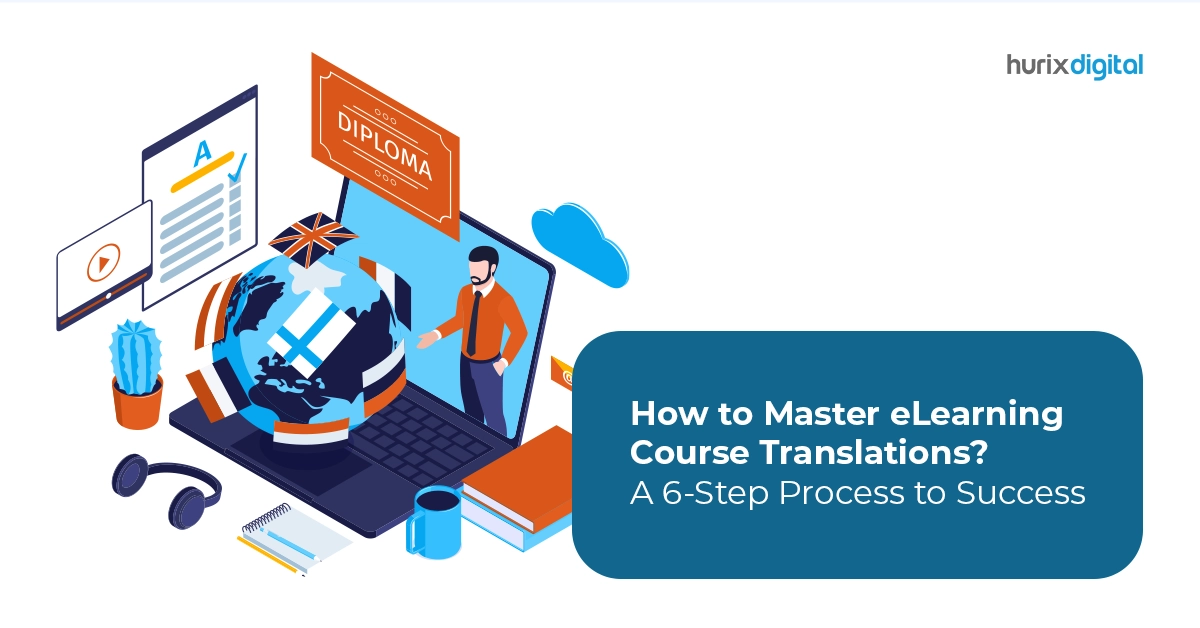
How to Master eLearning Course Translations? A 6-Step Process to Success
Summary
Explore a step-by-step process for mastering eLearning course translations. This article provides practical advice for ensuring accurate and effective translations.
Organizations are increasingly seeking to expand their reach and engage with a global audience. For such an expansion, they are required to translate eLearning courses into the native languages of their diverse workforce.
However, language adaptation in eLearning is tedious, especially when you want 100% accuracy, efficiency, and cost-effectiveness. It requires a strategic approach and the use of advanced technology to ensure a seamless and effective translation process.
Our detailed guide breaks down the process for translating eLearning courses into six simple steps to help you effectively bridge language barriers and deliver impactful learning experiences to your global workforce. Let’s get exploring!
Table of Contents:
6 Simple Steps to Translate eLearning Courses in 2024
Localization in eLearning promotes inclusivity and collaboration and helps create a lasting impact on your readers. Also, it enhances the overall learning experience for a diverse audience.
The process of eLearning course translations can be surprisingly straightforward with the right approach. But you need to follow a structured plan to ensure success.
Below are six simple steps you need to follow to ensure successful translation of eLearning courses in 2024:
1. Analyze the Source Content
Planning is the most essential step in any procedure. Before you begin the process of translating learning materials, take the time to analyze your eLearning course. The analysis involves separating the textual content, visuals, and audio narration.
Sorting out the different elements of your eLearning content streamlines the process and ensures that each aspect receives specialized attention.
Analysis of course material before translation sets the stage for a smooth and efficient translation process. Proper content segregation can reduce expenses incurred on translation services by avoiding unnecessary work on non-translatable elements. So, make sure to analyze your source content thoroughly before proceeding with the translation process.
2. Translate the Course
Once your content is neatly categorized, it is time to contact a vendor who can create specialized translation templates for each type of content, like text, visuals, and audio. Such templates act as blueprints, ensuring consistency and clarity for the linguists working on your project.
They serve as pre-formatted canvases where experts with language and subject matter expertise work their magic and translate your content efficiently without errors. It helps maintain a consistent voice and style throughout your translated course in an uncomplicated way that facilitates cross-cultural eLearning.
In this regard, make sure you also consider the following steps as you proceed with the translation of your eLearning course:
- Partner with professional translators who specialize in the subject matter of your eLearning content.
- Offer comprehensive guidelines to translators, including the context of the course, the intended audience, and any specific terminology or style preferences.
- Implement translation memory to store previously translated segments and maintain consistency across the course.
- Be aware of localization challenges, especially regarding idioms, cultural references, or region-specific content.
These are some best practices for eLearning localization that will contribute to a successful and effective translation process.
Also Read: 6 Benefits of Investing in Custom eLearning Courses for Your Enterprise
3. Proofread the Translated Content Thoroughly
Accuracy is paramount in eLearning translations. You do not want your content to fall flat on its face due to translation errors. To keep your hard work from being lost in translation, proofread your translated content rigorously.
Proofreading typically involves two layers of review:
- Linguistic Expertise: Hire a language expert to examine the translated content thoroughly for grammatical accuracy, cultural nuances, and adherence to the target language’s natural flow and style.
- Subject Matter Expertise: Have a subject matter expert in your team who understands the course content in depth to review the translated materials for technical accuracy. An expert will ensure that the translated information aligns perfectly with the intended learning objectives.
4. Schedule a Professional Voice Talent for Audio Narration
Engaging audio narration plays a crucial role in providing a wholesome eLearning experience. You can select a suitable voice talent from a pool of professional narrators that your vendor suggests after finalizing the textual content.
Choosing a voice that resonates with your target audience is essential for maximizing learner engagement. Ensure that the voice complements the overall tone of the course. Be mindful to choose a service that fits your budget and provides a service that suits your requirements perfectly.
5. Integrate the Translated Elements into Your Course
Once everything is translated and narrated, it’s time to put the pieces back together! It is like putting a puzzle in place with precise synchronization of translated text, visual elements, and audio narration.
The final product must be cohesive to ensure a consistent learning experience for your global audience. Your quality assurance team must conduct a thorough review of the integrated course.
The comprehensive examination verifies proper synchrony across all elements and identifies potential inconsistencies that hinder the learning experience. By adhering to these rigorous integration and review procedures, you can guarantee a polished and seamless translated course that effectively delivers knowledge to your learners.
6. Deliver the Course to the LMS
After checking all the technical boxes, it is time to make sure that the course speaks the same language as your learning platform.
You must ensure compliance with industry standards like SCORM, a universal translator for different learning systems. It allows you to upload the translated course to your Learning Management System (LMS) and opens doors to global eLearning.
Once everything clicks into place, your learners worldwide can access the training materials in their native language and gain valuable knowledge and skills.
Also Read: 7 Key Principles for Designing Engaging eLearning Courses
Wrapping Up
Taking the first step towards globalized learning is easier than you think.
By following the comprehensive 6-step process mentioned above, you can effectively translate your eLearning courses to cater to the diverse needs of your global workforce.
In this regard, partnering with a reputable eLearning translation provider like Hurix Digital can streamline the process and ensure exceptional results for multilingual eLearning.
Our team of experienced subject matter experts possesses the necessary skills to deliver high-quality, culture-sensitive translations that resonate with your learners and contribute to a sought-after global learning strategy.
Contact us to create a globalized learning experience for your consumers in 2024 and beyond.

Performance, Results, Growth, and Life-Long Learning define my professional life. I am passionate about making workplace learning planful, purposeful, and impactful. I take pride in partnering with clients and bringing them the best in learning design and creating solutions that address business challenges.


